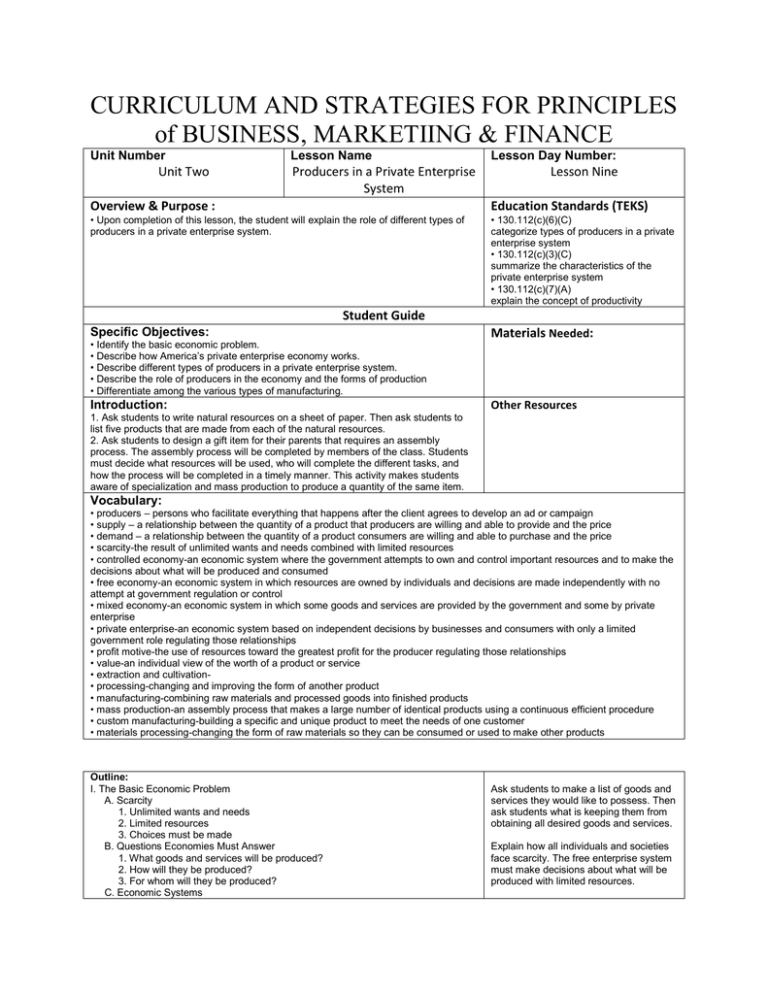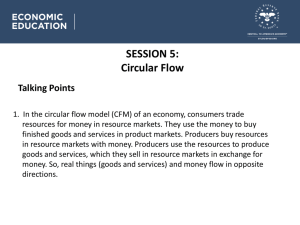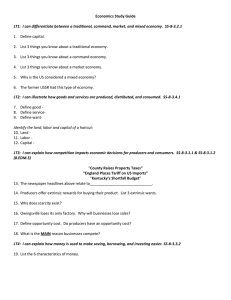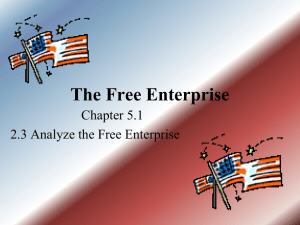Specific Objectives
advertisement

CURRICULUM AND STRATEGIES FOR PRINCIPLES of BUSINESS, MARKETIING & FINANCE Unit Number Unit Two Lesson Name Producers in a Private Enterprise System Lesson Day Number: Lesson Nine Overview & Purpose : Education Standards (TEKS) • Upon completion of this lesson, the student will explain the role of different types of producers in a private enterprise system. • 130.112(c)(6)(C) categorize types of producers in a private enterprise system • 130.112(c)(3)(C) summarize the characteristics of the private enterprise system • 130.112(c)(7)(A) explain the concept of productivity Student Guide Specific Objectives: • Identify the basic economic problem. • Describe how America’s private enterprise economy works. • Describe different types of producers in a private enterprise system. • Describe the role of producers in the economy and the forms of production • Differentiate among the various types of manufacturing. Introduction: Materials Needed: Other Resources 1. Ask students to write natural resources on a sheet of paper. Then ask students to list five products that are made from each of the natural resources. 2. Ask students to design a gift item for their parents that requires an assembly process. The assembly process will be completed by members of the class. Students must decide what resources will be used, who will complete the different tasks, and how the process will be completed in a timely manner. This activity makes students aware of specialization and mass production to produce a quantity of the same item. Vocabulary: • producers – persons who facilitate everything that happens after the client agrees to develop an ad or campaign • supply – a relationship between the quantity of a product that producers are willing and able to provide and the price • demand – a relationship between the quantity of a product consumers are willing and able to purchase and the price • scarcity-the result of unlimited wants and needs combined with limited resources • controlled economy-an economic system where the government attempts to own and control important resources and to make the decisions about what will be produced and consumed • free economy-an economic system in which resources are owned by individuals and decisions are made independently with no attempt at government regulation or control • mixed economy-an economic system in which some goods and services are provided by the government and some by private enterprise • private enterprise-an economic system based on independent decisions by businesses and consumers with only a limited government role regulating those relationships • profit motive-the use of resources toward the greatest profit for the producer regulating those relationships • value-an individual view of the worth of a product or service • extraction and cultivation• processing-changing and improving the form of another product • manufacturing-combining raw materials and processed goods into finished products • mass production-an assembly process that makes a large number of identical products using a continuous efficient procedure • custom manufacturing-building a specific and unique product to meet the needs of one customer • materials processing-changing the form of raw materials so they can be consumed or used to make other products Outline: I. The Basic Economic Problem A. Scarcity 1. Unlimited wants and needs 2. Limited resources 3. Choices must be made B. Questions Economies Must Answer 1. What goods and services will be produced? 2. How will they be produced? 3. For whom will they be produced? C. Economic Systems Ask students to make a list of goods and services they would like to possess. Then ask students what is keeping them from obtaining all desired goods and services. Explain how all individuals and societies face scarcity. The free enterprise system must make decisions about what will be produced with limited resources. 1. Controlled economy-government answers the three economic questions 2. Free economy (market economy)-resources are owned by individuals rather than the government 3. Mixed economy-decisions are made independently with no attempt at government regulation or control II. America’s Private Enterprise Economy A. based on independent decisions by businesses and consumers with only a limited government role regulating those relationships B. Characteristics of Private Enterprise 1. resources of production are owned and controlled by individual producers 2. Producers use the profit motive to decide what to produce-use of resources to obtain the greatest profit 3. Individual consumers make decisions about what will be purchased to satisfy needs 4. Consumers use value in deciding what to consume 5. Government stays out of exchange activities between producers and consumers unless it is clear that individuals or society are harmed by the decisions C. Consumers 1. Individuals who purchase products and services to satisfy needs 2. Demand-a relationship between the quantity of a product consumers are willing and able to purchase and the price D. Producers-businesses that use their resources to develop products and services to consumers for profit 1. Supply-relationship between the quantity of a product that producers are willing and able to provide and the price 2. Determine the needs and demands of consumers E. Government 1. least amount of involvement in free enterprise system 2. some regulations 3. use taxes for services III. Business Customer Classifications A. Producers-1.2 million businesses 1. farms and ranches 2. mining companies 3. oil refineries 4. manufacturers of business and consumer products 5. construction-largest production category-over 700,000 companies 6. small-less than $10,000 a year on purchases 7. large-employ several hundred thousand people worldwide and may easily spend $10 million in one day on purchases B. Resellers-wholesale and retail businesses who connect producers with consumers C. Service Businesses-growing faster than any category of business in the U.S. D. Government-federal, state and local government agencies provide services to citizens and develop and enforce laws and regulations E. Nonprofit Organizations-serve the community with no profit motive IV. Forms of Production A. Extraction and cultivation-products are obtained from nature or grown using natural resources B. Processing-changing and improving the form of another product C. Manufacturing-combines raw materials and processed goods into finished products 1. manufacturing process-several manufacturers are part of the total activity needed to produce goods that are purchased by consumers or other businesses 2. Types of Manufacturing Procedures a. Mass Production-assembly process that makes a large number of identical products using a continuous, efficient procedure b. Custom Manufacturing-building a specific and unique product to meet the needs of one customer c. Materials Processing-changing the form of raw materials so they can be consumed or used to make other products d. Intermittent Processing-uses short production runs to produce a precise amount of a variation of a product e. continuous processing-raw materials constantly move through specially designed equipment changing them into a specific product useable for consumption Looking Forward: Q: How does a manufacturer differ from an extractor? A: The extractor takes resources from nature for direct consumption or for use in developing other products. Manufacturers get supplies from other producers and Ask students to list the three economic systems on a sheet of paper and to list advantages and disadvantages for each economic system. Explain how consumers decide what is produced in a free enterprise system. Producers must listen to consumer demands to stay in business. The free enterprise system does not want a lot of government involvement. Producers must decide how they will use their limited resources. A farmer must determine which crops to grow; car manufacturers must determine the quantity of different types of automobiles to produce. Producers come in all types and sizes. The manufacturing, construction, agriculture, and extracting industries carefully consider consumer demand and economic conditions when determining what to produce and the quantity to produce. Ask students to give examples of producer involved with extraction and cultivation. Ask students what processes are required to produce a pair of cotton jeans. Explain the variety of producers used in the process. Explain how large home builders construct tract homes which use a mass production concept and how custom builders design a different home for each customer. Then explain why the custom process is more expensive than the mass production process. convert them into products. Q: What are the three forms of production? A: The three forms of production are extraction and cultivation, processing, and manufacturing. Q: What is intermittent processing? A: Intermittent processing uses short production runs to produce a precise amount of a variation of a product. Q: What is custom manufacturing? A: Custom manufacturing involves building a specific and unique product to meet the needs of one consumer. Q: What is the fasting growing type of business? A: Service businesses are the fastest growing category. Q: What is manufacturing? A: Manufacturing combines raw materials and processed goods into finished products. Q: Why would the processing of textbooks be an intermittent process? A: Books would be produced as dictated by the flow of orders. BED AND BREAKFAST Ask students how a farmer or rancher could become involved with a bed and breakfast. Then ask students to explain the products and services provided by the bed and breakfast operated by the farmer or rancher. Students will present their plan to the class.






